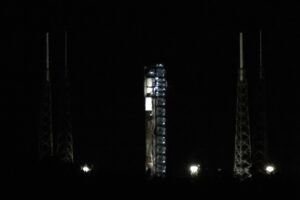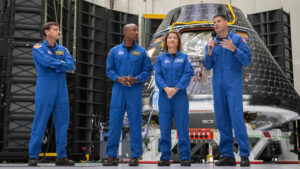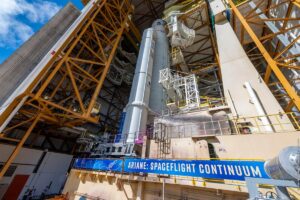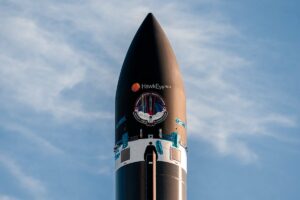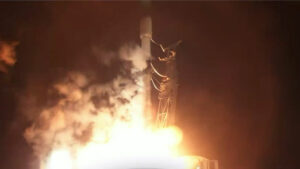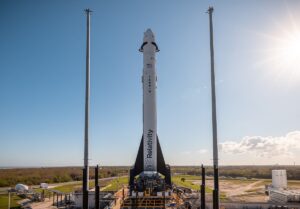Updated 7:20 p.m. EDT (2320 UTC): Hurricane Hilary delays California launch further.
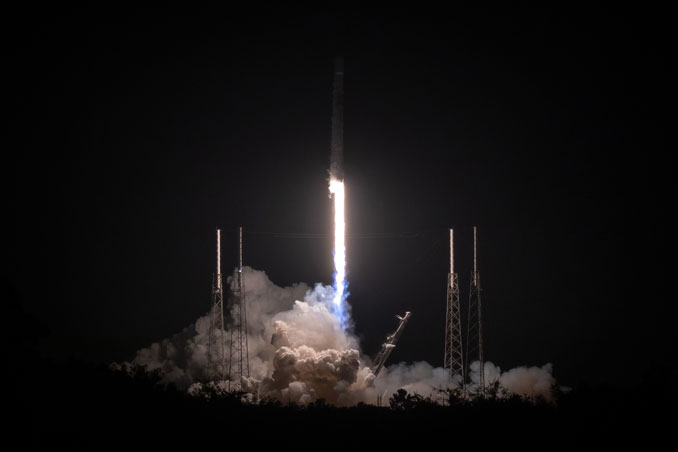
A Falcon 9 lifted off from Cape Canaveral late Wednesday carrying 22 Starlink satellites but a launch from California scheduled for just hours later was delayed, dashing SpaceX’s plans for back-to-back launches for its broadband internet service.
The Starlink 6-10 mission lit up the Florida night sky with a thunderous liftoff from pad 40 at Cape Canaveral Space Force Station at 11:36 p.m. EDT on Wednesday, Aug. 16 (0336 UTC on the 17th). It had originally been scheduled to fly three hours earlier but slipped to the fourth of five available launch opportunities. Thunderstorms had rolled through the Cape Canaveral area in the afternoon and evening but SpaceX did not say if weather or technical problems caused the launch time to slip. In the end Space Force meteorologists reported the weather was 90-percent ‘go’ for the rescheduled launch.
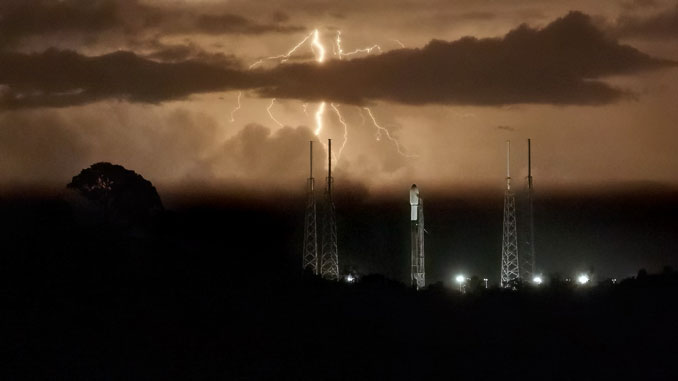
The first stage booster, tail number B1067 in the SpaceX fleet, successfully landed on the drone ship ‘A Short Fall of Gravitas’ about eight and half minutes after liftoff. It was the 171st successful landing at sea and the 217th recovery overall for the reusable rocket. SpaceX recovery ship Doug was to recover the payload fairing halves. One half of the payload fairing had flown 10 times and the other 11 times.
Following two burns of the Falcon 9 second-stage, separated by a 45-minute coast phase, the 22 Starlink satellites were successfully deployed into their target orbit of 182×176 miles (293×284 km) with an inclination of 43 degrees with confirmation coming via a tracking station on the Pacific island of Guam.
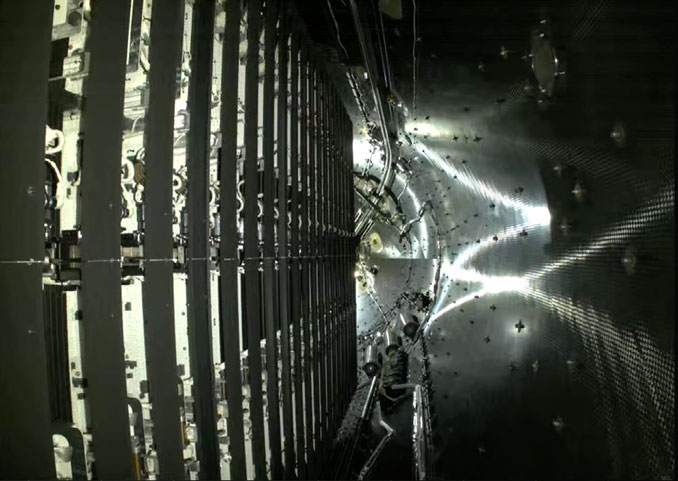
Attention then turned to the launch of another batch of Starlink satellites, this time 21 spacecraft flying from Vandenberg Space Force Base in California. Launch was originally scheduled for 12:01 a.m. PDT (3:01 a.m EDT, 0701 UTC) Thursday but with the Cape Falcon 9 launched, SpaceX repeatedly delayed the west coast launch to its third opportunity, then its fourth and then the end of the window at 3:35 a.m. PDT (6:35 a.m. EDT / 1035 UTC). Eventually the launch was scrubbed for the day and rescheduled for early Friday. The company did not say if a technical problem or weather was responsible for the delay.
Then on Thursday SpaceX announced a further delay. With Hurricane Hilary bearing down on the west coast and high seas in the booster recovery zone, the launch is on hold until Monday at the earliest.
According to statistics tabulated by Jonathan McDowell, an astronomer at the Harvard-Smithsonian Center for Astrophysics who maintains a space flight database, with Wednesday’s launch from Florida SpaceX has launched a total of 4,962 Starlink satellites into orbit.
It was the 99th Falcon 9 flight with Starlink satellites as the primary payload and the 12th launch of the so-called V2 mini satellites which are larger and have four times the bandwidth of the previous models.
Watch a replay of our launch coverage:
[embedded content]
- SEO Powered Content & PR Distribution. Get Amplified Today.
- PlatoData.Network Vertical Generative Ai. Empower Yourself. Access Here.
- PlatoAiStream. Web3 Intelligence. Knowledge Amplified. Access Here.
- PlatoESG. Automotive / EVs, Carbon, CleanTech, Energy, Environment, Solar, Waste Management. Access Here.
- PlatoHealth. Biotech and Clinical Trials Intelligence. Access Here.
- ChartPrime. Elevate your Trading Game with ChartPrime. Access Here.
- BlockOffsets. Modernizing Environmental Offset Ownership. Access Here.
- Source: https://spaceflightnow.com/2023/08/17/starlink-satellites-soar-from-florida-west-coast-launch-slips/
- :has
- :is
- :not
- ][p
- $UP
- 10
- 11
- 12
- 16
- 20
- 22
- 36
- 40
- 7
- 9
- a
- About
- Adam
- After
- an
- and
- announced
- Another
- ARE
- AREA
- AS
- astrophysics
- At
- Aug
- available
- Bandwidth
- base
- been
- booster
- broadband
- burns
- but
- by
- california
- camera
- carrying
- caused
- Center
- Coast
- coming
- company
- confirmation
- content
- continue
- countdown
- coverage
- Database
- day
- delay
- Delayed
- delays
- deployed
- DID
- doug
- down
- drone
- due
- during
- Earlier
- earliest
- Early
- embedded
- enabling
- end
- evening
- eventually
- falcon
- Falcon 9
- Fall
- First
- five
- FLEET
- flight
- florida
- flying
- For
- Force
- four
- Fourth
- Friday
- from
- further
- Glimpse
- had
- Half
- Have
- High
- hold
- HOURS
- http
- HTTPS
- hurricane
- if
- image
- in
- inside
- Internet
- into
- island
- IT
- ITS
- jonathan
- jpg
- just
- landing
- larger
- Late
- later
- launch
- launched
- launches
- Lifted
- maintains
- max-width
- MCDOWELL
- minutes
- Mission
- models
- Monday
- moved
- night
- now
- number
- of
- off
- on
- Onboard
- ONE
- opportunities
- Opportunity
- or
- Orbit
- originally
- Other
- our
- overall
- Pacific
- pad
- phase
- plans
- plato
- Plato Data Intelligence
- PlatoData
- player
- previous
- primary
- Problem
- problems
- Recover
- recovery
- REPEATEDLY
- Reported
- responsible
- reusable
- rocket
- Rolled
- satellites
- say
- scheduled
- SEA
- service
- Short
- sky
- Space
- Space Force
- spacecraft
- spaceflight
- SpaceX
- Stage
- starlink
- station
- statistics
- successful
- Successfully
- Target
- Technical
- The
- The West
- their
- then
- Third
- this
- three
- Through
- thursday
- time
- times
- to
- Total
- Tracking
- Turned
- two
- until
- UTC
- via
- Video
- was
- Weather
- Wednesday
- were
- West
- which
- WHO
- window
- with
- youtube
- zephyrnet



